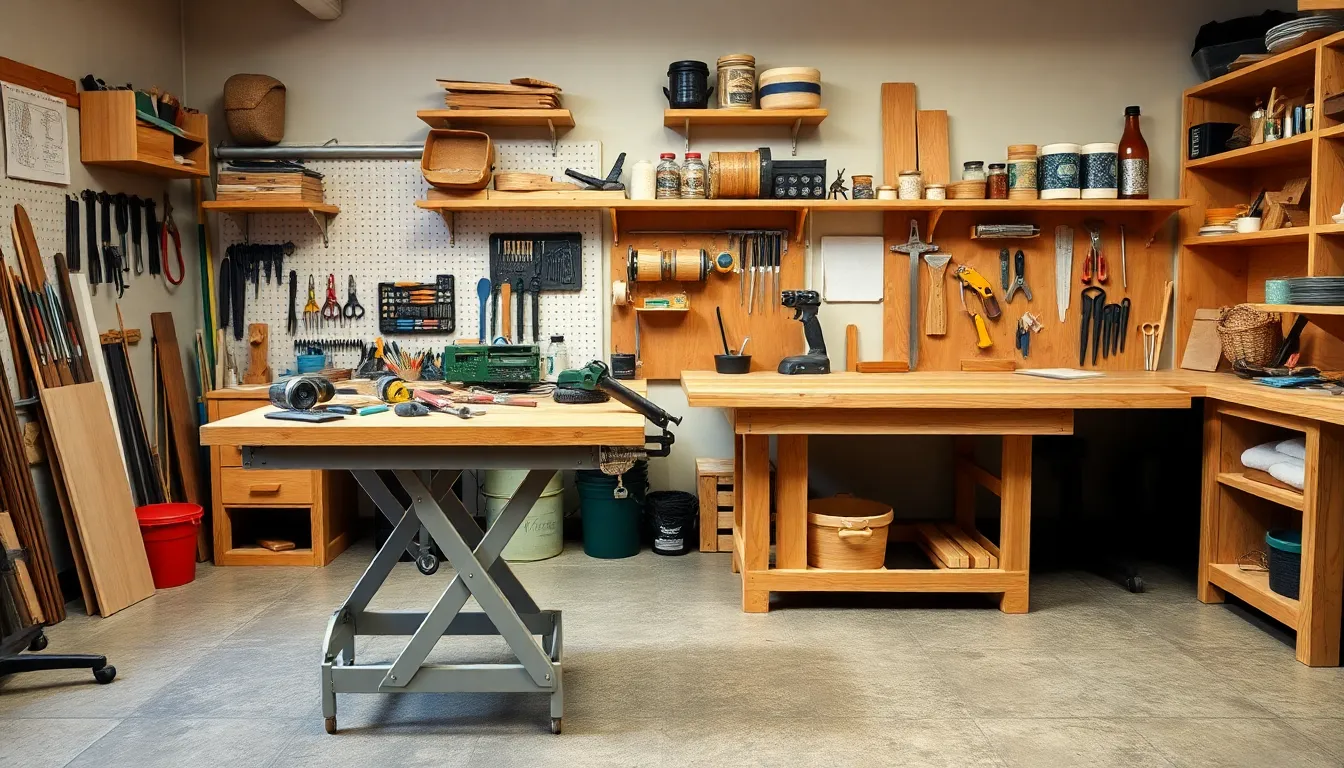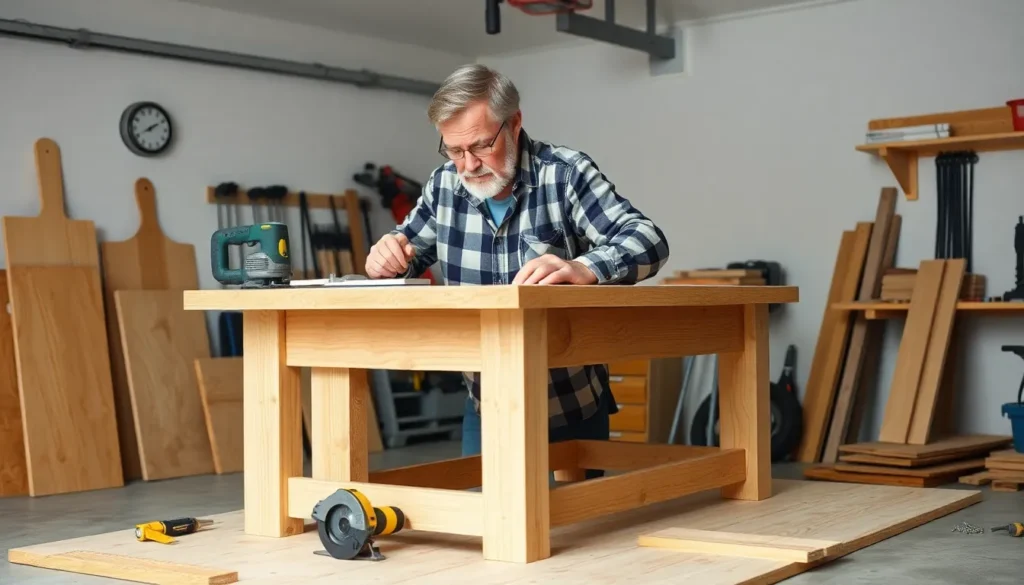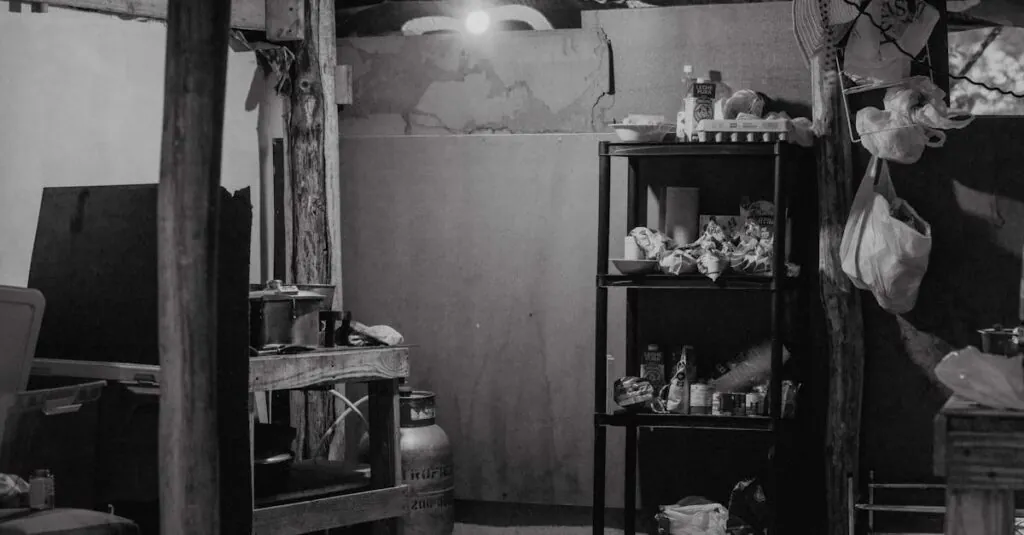Table of Contents
ToggleCrafting the perfect workbench can feel like a rite of passage for any DIY enthusiast. It’s not just a piece of furniture; it’s a sanctuary for creativity and a battleground for projects gone awry. With the right workbench plans, anyone can transform a cluttered garage into a haven of productivity—where every saw cut and hammer strike brings them one step closer to their masterpiece.
Overview of Workbench Plans
Workbench plans provide essential guidance for building efficient and customized workstations. These plans encompass design elements, materials list, and step-by-step instructions, enabling individuals to achieve their desired workspace. Clarity in the plans ensures DIY enthusiasts can follow along, resulting in a well-constructed workbench.
Materials play a crucial role in crafting a sturdy workbench. Common options include plywood, hardwood, and MDF, which offer varying durability and cost. Selecting the right materials affects the overall strength and longevity of the workbench. Including features like built-in storage and tool organization can further enhance usability.
Design styles vary widely among workbench plans. Options range from simple, minimalistic designs to complex ones with multiple surfaces and features. The chosen style should reflect the intended use, whether for woodworking, electronics, or crafting. Also, dimensions matter; tailoring the size of the workbench to fit available space ensures practicality.
Safety is another vital aspect addressed in workbench plans. Clear guidelines on securing tools and using protective gear contribute to a safer working environment. Additionally, incorporating proper lighting can prevent accidents and improve focus during projects.
Workbench plans also promote organization and efficiency. Arranging tools and materials for easy access enables smoother workflow. By following these plans, individuals turn their creative visions into tangible results, transforming spaces for productive use.
Types of Workbench Plans

Workbench plans come in various types, each catering to specific needs and projects. Understanding these types helps DIY enthusiasts choose the right design for their workspace.
Portable Workbenches
Portable workbenches offer flexibility and convenience. Designed for easy transport, they allow for quick setup in various locations. Many models feature collapsible frames, making storage effortless. These workbenches often include integrated storage options, providing space for tools and materials during projects. Constructing a portable workbench requires lightweight materials like plywood or aluminum, ensuring durability without excess weight. Many hobbyists appreciate their versatility for tasks ranging from woodworking to crafting on the go.
Stationary Workbenches
Stationary workbenches provide stability and robustness. Built for specific tasks like woodworking or metalworking, they often feature a solid surface to withstand heavy use. Materials such as hardwood or MDF enhance their longevity, making them a reliable choice for serious crafters. These workbenches typically incorporate storage solutions like drawers or shelves, allowing for organized tool placement. Designing a stationary workbench requires consideration of available space and intended projects, ensuring the structure complements the user’s workflow effectively.
Essential Features of Workbench Plans
Workbench plans must incorporate key features that enhance functionality and usability. These crucial elements help DIY enthusiasts create workstations tailored to their specific needs.
Material Considerations
Materials significantly impact the workbench’s strength and lifespan. Plywood offers a balance between affordability and durability, making it a popular choice for many projects. Hardwood provides robustness, ideal for intensive use and ensuring long-term stability. MDF is lightweight and smooth, perfect for surfaces requiring precision work. Selecting appropriate materials ensures that the workbench withstands heavy workloads while providing an optimal workspace.
Size and Dimensions
Size and dimensions play a vital role in a workbench’s effectiveness. A standard height of 30 to 36 inches accommodates various users comfortably. Width varies based on intended tasks, with a range of 24 to 60 inches catering to both small and large projects. Depth should ideally be between 24 and 36 inches, allowing for ample workspace without overwhelming the area. Adjusting these dimensions ensures that the workbench fits seamlessly in any workshop, enhancing usability and comfort.
Tools and Materials Needed
Constructing a workbench requires specific tools and materials for effective and successful assembly. Knowing these essential items helps streamline the building process.
Tools:
- Circular Saw – A circular saw offers the precision needed for cutting plywood and hardwood.
- Drill/Driver – A drill/driver assists in creating holes for screws and fastening components securely.
- Measuring Tape – Measuring tape ensures accurate dimensions for each piece, maintaining alignment.
- Square – A square checks for right angles, guaranteeing structural integrity in joints and corners.
- Sander – A sander smooths surfaces, preventing splinters and ensuring a finished look.
Materials:
- Plywood – Plywood serves as a sturdy surface, ideal for various workbench projects.
- Hardwood – Hardwood offers additional strength, enhancing durability for heavy-duty tasks.
- MDF – Medium-density fiberboard (MDF) provides a smooth, even surface for delicate work and ideal for creating a flat top.
- Screws – Quality screws secure the workbench components, ensuring longevity and stability.
- Wood Glue – Wood glue enhances the bond between surfaces, reinforcing the structure.
A workbench may also benefit from accessories like clamps and vises, which aid in holding materials securely while working. Opting for quality materials and tools saves time, effort, and minimizes frustration in the building process. Combining these equipment pieces effectively creates a reliable and efficient workspace tailored to personal needs.
Popular Workbench Plans
Plans for workbenches cater to a variety of needs. Each type offers unique features and design elements tailored to specific tasks and preferences.
DIY Workbench Plans
DIY workbench plans encourage creativity and customization. Enthusiasts can choose layouts that suit their individual projects, such as woodworking or crafting. These plans often include detailed instructions, material suggestions, and dimensions, ensuring clarity throughout the building process. Many DIY plans focus on utilizing accessible materials like plywood and hardwood, fostering flexibility in construction. Additional features often involve integrated storage solutions, allowing for efficient organization of tools and materials. Designs adaptable to various workspace sizes enhance usability and functionality.
Commercial Workbench Plans
Commercial workbench plans prioritize durability and robustness. Typically designed for industrial or professional environments, these plans consist of high-quality materials like steel and thick plywood. Workspaces requiring heightened stability often benefit from heavy-duty construction features. Many commercial designs accommodate specialized tasks, integrating features such as power outlets and built-in tool storage. These plans promote efficiency in busy settings, streamlining workflows for multiple users. Organizations often prefer designs that can withstand frequent use while providing ample workspace for various projects.
Crafting the perfect workbench is a rewarding journey for any DIY enthusiast. With the right plans and materials individuals can create a workspace that not only meets their project needs but also inspires creativity.
Choosing the right design and understanding the various types of workbenches ensures that each person can tailor their setup to fit their unique workflow. Prioritizing safety and organization further enhances the experience making it easier to tackle any project.
Ultimately a well-built workbench serves as a foundation for countless creative endeavors transforming ideas into reality.





